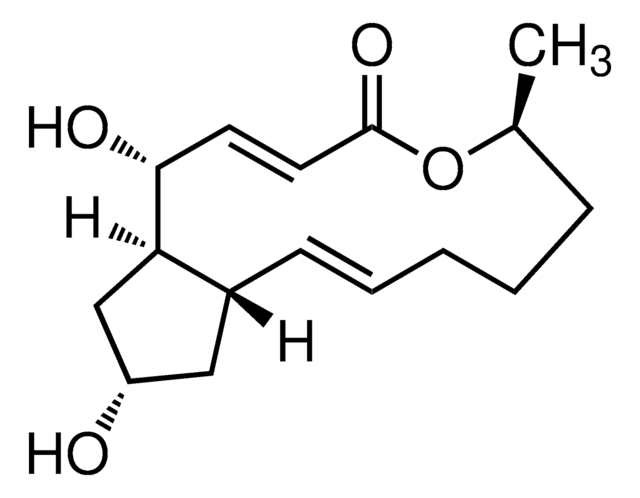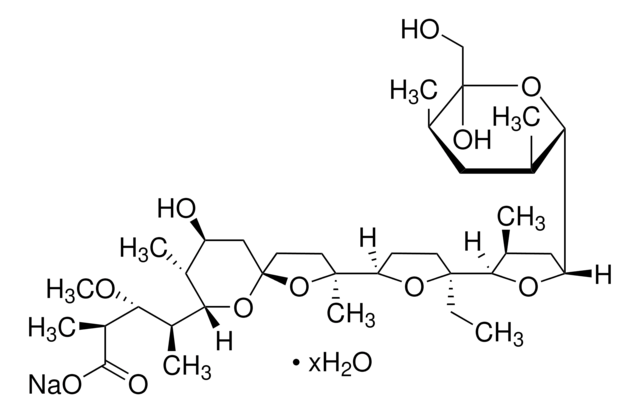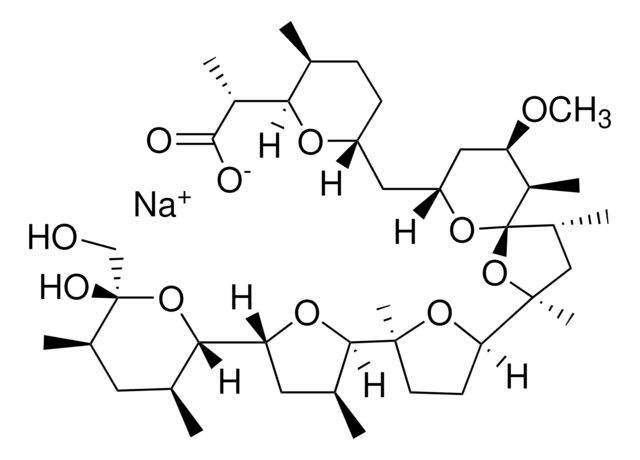M5273
Monensin sodium salt
90-95% (TLC)
Sinónimos:
Monensin A sodium salt
About This Item
Productos recomendados
Nivel de calidad
Análisis
90-95% (TLC)
espectro de actividad antibiótica
Gram-negative bacteria
Gram-positive bacteria
fungi
parasites
viruses
Modo de acción
cell membrane | interferes
temp. de almacenamiento
2-8°C
cadena SMILES
[H][C@]1([C@@]2(CC)O[C@]([C@@]3(C)OC4(C[C@H](O)[C@@H](C)[C@@]([H])([C@@H](C)[C@@H](OC)[C@@H](C([O-])=O)C)O4)CC3)([H])CC2)[C@@H](C)C[C@]([H])([C@@]5([H])O[C@@](O)(CO)[C@H](C)C[C@@H]5C)O1.[Na+]
InChI
1S/C36H62O11.Na/c1-10-34(31-20(3)16-26(43-31)28-19(2)15-21(4)36(41,18-37)46-28)12-11-27(44-34)33(8)13-14-35(47-33)17-25(38)22(5)30(45-35)23(6)29(42-9)24(7)32(39)40;/h19-31,37-38,41H,10-18H2,1-9H3,(H,39,40);/q;+1/p-1/t19-,20-,21+,22+,23-,24-,25-,26+,27+,28-,29+,30-,31+,33-,34-,35?,36-;/m0./s1
Clave InChI
XOIQMTLWECTKJL-BEMBKCOJSA-M
¿Está buscando productos similares? Visita Guía de comparación de productos
Descripción general
Aplicación
- for the intracellular staining of cytokines
- to study its effects on the regulation of nuclear factor-κ B (NF-κB ) activation
- as a positive control to study its effects on in vitro rumen fermentation
Acciones bioquímicas o fisiológicas
Nota de preparación
Palabra de señalización
Danger
Frases de peligro
Consejos de prudencia
Clasificaciones de peligro
Acute Tox. 2 Oral - Aquatic Chronic 2 - Eye Irrit. 2 - STOT RE 2
Órganos de actuación
Heart,muscle
Código de clase de almacenamiento
6.1A - Combustible acute toxic Cat. 1 and 2 / very toxic hazardous materials
Clase de riesgo para el agua (WGK)
WGK 3
Punto de inflamabilidad (°F)
Not applicable
Punto de inflamabilidad (°C)
Not applicable
Equipo de protección personal
Eyeshields, Faceshields, Gloves, type P2 (EN 143) respirator cartridges
Certificados de análisis (COA)
Busque Certificados de análisis (COA) introduciendo el número de lote del producto. Los números de lote se encuentran en la etiqueta del producto después de las palabras «Lot» o «Batch»
¿Ya tiene este producto?
Encuentre la documentación para los productos que ha comprado recientemente en la Biblioteca de documentos.
Los clientes también vieron
Nuestro equipo de científicos tiene experiencia en todas las áreas de investigación: Ciencias de la vida, Ciencia de los materiales, Síntesis química, Cromatografía, Analítica y muchas otras.
Póngase en contacto con el Servicio técnico












